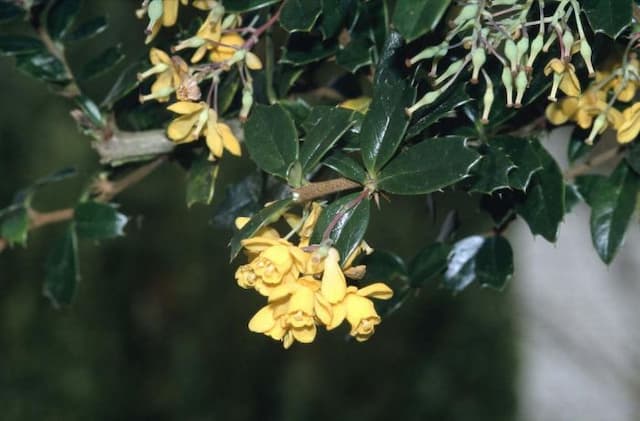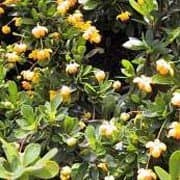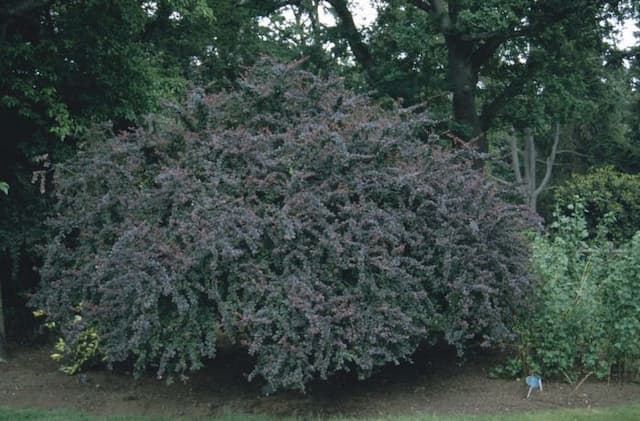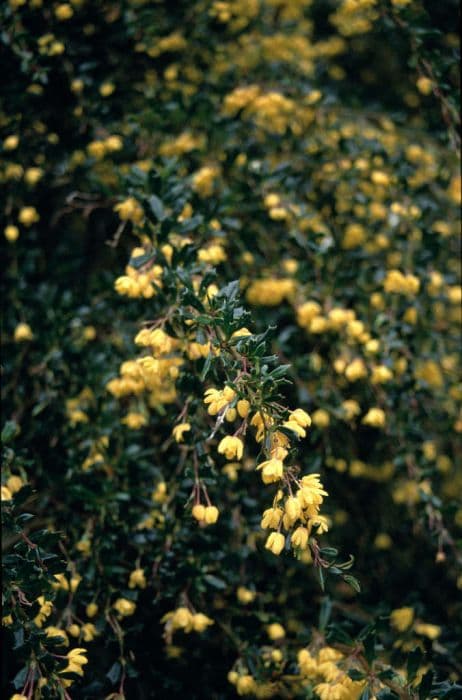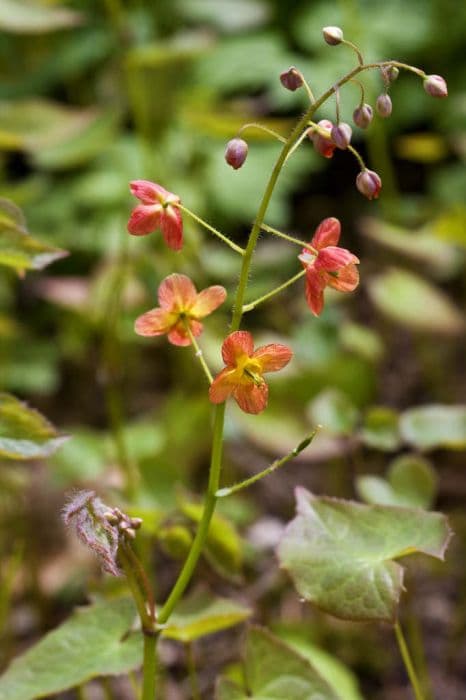Bishops Hat Epimedium × versicolor 'Sulphureum'

ABOUT
The plant commonly known as Bishop's Hat is a captivating perennial that displays a lively combination of foliage and flowers. It boasts heart-shaped leaves that emerge in a flush of red and bronze tones before maturing to a soft green, often with a delicate mottling of lighter hues. As the seasons change, the foliage can again turn shades of bronze and red, offering a dynamic spectacle throughout the year. The flowers of Bishop's Hat stand out with spidery elegance. They delicately dangle from slender stems and exhibit a charming, light yellow hue, adding a soft, sulphurous tint to the garden from mid to late spring. The petals are carried aloft above the foliage, resembling tiny, cheerful lanterns swaying in the breeze. The blossoming period presents a lovely contrast with the greenery beneath, creating a delightful visual interest that beckons a closer look. Though subtle in its demeanor, Bishop's Hat's nuanced beauty can serve as a gentle highlight in shade gardens or mixed borders.
About this plant
 Names
NamesFamily
Berberidaceae
Synonyms
Bicolor Epimedium, Sulphur Epimedium, Yellow Epimedium
Common names
Epimedium × versicolor 'Sulphureum'.
 Toxicity
ToxicityTo humans
Bishops hat, also known as Epimedium × versicolor 'Sulphureum', is not commonly known to be toxic to humans. Ingestion of this plant typically does not cause poisoning or hazardous symptoms. However, as with any non-food plant, individual allergies and adverse reactions can occur, so it is generally advised to avoid eating any part of ornamental plants.
To pets
Bishops hat does not have a known toxicity to pets such as dogs and cats. It is not typically associated with causing poisoning if ingested by pets. However, as with any plant material, ingestion in large quantities could potentially cause gastrointestinal upset such as vomiting or diarrhea due to the irritation of the stomach or intestines. It's always prudent to monitor your pets around plants and discourage them from chewing on any plant material to prevent any possible upset or unforeseen reactions.
 Characteristics
CharacteristicsLife cycle
Perennials
Foliage type
Semi-deciduous
Color of leaves
Varies
Flower color
Yellow
Height
12-18 inches (30-45 cm)
Spread
12-24 inches (30-60 cm)
Plant type
Herb
Hardiness zones
5
Native area
Asia
Benefits
 General Benefits
General Benefits- Drought Tolerance - Once established, it can survive periods of low water availability.
- Shade Tolerance - Thrives in partial to full shade, making it suitable for woodland gardens or darker areas of the yard.
- Ground Cover - Its dense growth habit suppresses weeds and covers the ground effectively.
- Low Maintenance - Requires minimal pruning and care once established.
- Attracts Pollinators - Flowers provide nectar for bees and other beneficial insects.
- Erosion Control - The root system helps to stabilize soil on slopes and banks.
- Seasonal Interest - Offers attractive foliage and flowers that add visual interest during spring.
- Deer Resistance - Generally resistant to deer, which is beneficial in areas with high deer populations.
 Medical Properties
Medical Properties- Libido Enhancement: Commonly known as Bishop's Hat, this plant has been traditionally used in Chinese herbal medicine to improve libido and sexual function.
- Osteoporosis Treatment: The icariin compound found in Bishop's Hat is thought to have potential in preventing or treating osteoporosis by promoting bone health.
- Anti-inflammatory Effects: Bishop's Hat may have anti-inflammatory properties, which could be beneficial in reducing inflammation-related symptoms in various conditions.
- Antioxidant Activity: The plant contains flavonoids which are known for their antioxidant properties, potentially helping to protect cells from oxidative stress.
 Air-purifying Qualities
Air-purifying QualitiesThis plant is not specifically known for air purifying qualities.
 Other Uses
Other Uses- Bishop's Hat can be used as a ground cover for shaded or woodland areas, where its dense growth habit can effectively suppress weeds.
- In landscape design, Bishop's Hat is used for its attractive foliage and flowers to create a contrast with other shade-loving plants in border edges and rock gardens.
- This plant can serve as a companion plant in a mixed container garden, adding texture and a splash of color in the spring.
- Bishop's Hat is sometimes used as a living mulch under shrubs and trees, helping to regulate soil temperature and moisture.
- The plant can provide habitat for beneficial insects, such as certain bees and butterflies, which are attracted to its flowers.
- Its resilient nature makes Bishop's Hat a good candidate for restoration gardening, where it can help stabilize soil in disturbed or depleted landscapes.
- Gardeners may use the dried seed pods and leaves of Bishop's Hat in crafting, such as in creating natural wreaths or other dried floral arrangements.
- The foliage of Bishop's Hat can be a subtle backdrop in photography of garden landscapes, showcasing the various colors and textures of a well-planned garden.
- In areas with mild winters, Bishop's Hat can maintain semi-evergreen foliage, providing visual interest in the garden during the colder months.
- For educational purposes, Bishop's Hat can be included in botanical collections or in school gardens to teach about plant adaptation in shade environments.
Interesting Facts
 Feng Shui
Feng ShuiThe plant Epimedium is not used in Feng Shui practice.
 Zodiac Sign Compitability
Zodiac Sign CompitabilityThe plant Epimedium is not used in astrology practice.
 Plant Symbolism
Plant Symbolism- Endurance - Epimedium, commonly known as barrenwort, is a resilient plant that thrives in difficult conditions, symbolizing the ability to endure and persist.
- Longevity - Due to its ability to grow and thrive for many years, barrenwort represents long life and vitality.
- Adaptability - Barrenwort adapts well to various soil types and shades, symbolizing versatility and the ability to thrive in different environments.
- Protection - Traditionally used in herbal medicine, the barrenwort is believed to offer protective qualities, symbolizing safety and healing.
- Libido - As barrenwort is sometimes used as a natural aphrodisiac, it can symbolize sexual desire and fertility.
 Water
WaterBishop's Hat should be watered regularly, especially during dry periods, but it is important not to overwater. Generally, provide about an inch of water once a week, allowing the soil to dry slightly between waterings. During the growing season, ensure that the soil remains consistently moist but not waterlogged. In the winter, when the plant is dormant, reduce the frequency of watering, but do not let the soil become completely dry. It's best to water deeply and less frequently rather than little and often, which encourages deeper root growth and resilience in the plant.
 Light
LightBishop's Hat thrives best in partial shade to full shade. It should be placed in a spot that receives indirect sunlight or filtered light for most of the day. Avoiding direct afternoon sun is key as it can scorch the leaves of the plant. A north-facing or east-facing location where the plant can get morning light and afternoon shade is ideal.
 Temperature
TemperatureBishop's Hat is cold hardy and can withstand temperatures as low as -30 degrees Fahrenheit, but it grows best when the temperature ranges from 50 to 70 degrees Fahrenheit. In regions where the temperature exceeds 80 degrees Fahrenheit, the plant should be located in a spot that remains cool and shaded to protect it from heat stress.
 Pruning
PruningPrune Bishop's Hat to remove any damaged or dead foliage and to maintain its shape. Pruning is best done in late winter or early spring before new growth begins. This plant doesn't require frequent pruning; once a year is often enough unless shaping is desired. The best time for pruning is when it's still dormant to minimize stress on the plant.
 Cleaning
CleaningAs needed
 Soil
SoilBarrenwort thrives in moist, well-drained soil with high organic matter. A blend of loamy soil, peat or leaf mold, and perlite creates an ideal mix for root growth. Soil pH should be slightly acidic to neutral, around 5.5 to 7.0 for optimal health.
 Repotting
RepottingBarrenwort typically does not require frequent repotting. Repot every 3-4 years or when the plant outgrows its container, to refresh the soil and provide space for root expansion.
 Humidity & Misting
Humidity & MistingBarrenwort prefers a moderately humid environment, mirroring its natural woodland habitat. Nonetheless, it is quite adaptable and can tolerate lower humidity levels commonly found in home settings.
 Suitable locations
Suitable locationsIndoor
Place Barrenwort in bright, indirect light and keep soil consistently moist.
Outdoor
Plant Barrenwort in partial shade and moist, well-drained soil.
Hardiness zone
5-9 USDA
 Life cycle
Life cycleThe common name for Epimedium × versicolor 'Sulphureum' is Bicolor Barrenwort. Initial germination begins with seed dispersal, which generally occurs in spring or summer, with seeds sprouting in a moist, well-drained soil environment. These seedlings develop into a clump of heart-shaped, evergreen to semi-evergreen leaves that provide ground cover. The plant reaches maturity within two to three years, and in early to mid-spring, Bicolor Barrenwort produces yellow flowers with a distinctive spidery appearance. After flowering, seeds are formed and dispersed, continuing the reproductive cycle. Bicolor Barrenwort enters a period of dormancy in winter, with the foliage dying back in colder climates, before re-emerging in spring to start the cycle anew.
 Propogation
PropogationPropogation time
Spring to early summer
The Epimedium × versicolor 'Sulphureum', also known as Barrenwort, is ideally propagated in the late winter to early spring just before new growth begins. The most popular method of propagation for this plant is division. This involves carefully digging up an established clump and gently separating it into smaller sections, making sure that each section has a portion of the roots attached. These divisions can then be immediately replanted in well-prepared soil, ensuring that the crown of the plant is at soil level. It is important to water the new divisions thoroughly after planting and maintain even moisture until the plant is established. Barrenwort is a resilient plant, and this method of division allows for relatively quick establishment of the new plants, with the added benefit of rejuvenating older clumps that may have become woody or less vigorous.
